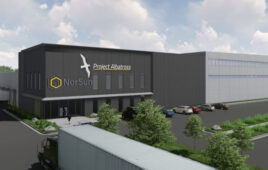The administration at Emory University, a private school of higher education from Georgia, set sustainability goals for the university, with plans to eliminate carbon emissions production by 2050. Emory has already installed solar arrays across many buildings on its main campus and is nearing completion of a solar canopy PV project at its Musculoskeletal Institute off-campus. Ben Damiani, chief technology officer at Cherry Street Energy, is here to share some details on the development and technology used in Emory’s latest solar endeavor.
A written portion of this podcast is below but be sure to listen to the full episode on your favorite podcast service.
Ben, what can you tell me about yourself and Cherry Street Energy?
Cherry Street Energy is a next-generation power company. We look to incorporate all of the power features for the future to make “Energy 2.0,” if you will. So that includes solar energy generation on site for commercial and industrial applications, as well as including battery backup, load shifting, electric vehicle infrastructure, resiliency — just what does the next generation of power look like? We try to be very forward thinking in how we deliver the next generation of power. And then for myself, I’m the chief technology officer and have a long history in solar.
Tell me about the customer and their needs, like what was the University’s requirements for the project?
Emory has been really forward thinking on trying to reduce their carbon footprint and transition over to renewable energy resources. We’ve actually partnered with them over the last five years. They want to get 5 MW of solar energy generation by 2026. We’ve been working on projects — on solar — putting it on their rooftops and then other parking garages to build solar canopies to provide shaded parking areas for this particular project. This is the sixth parking canopy that we have done with Emory.
What were your available choices to meet the customer’s needs?
We were used to working with other manufacturers of panels for some of the larger arrays. Panels continue to shift in size, and that always presents an updated design for us. Even though we had done a couple of these designs before with Emory, we had the option to consider some new structures.
One of the companies I had worked for in the past mentioned reaching out to PowerShingle and Nucor, and once we started getting into that product, it became really clear that there was something innovative there.
Why did you partner with Nucor?
It allowed for us to get some new technology built into project that we were looking for. We wanted to provide a weatherproof canopy provide expectation that when you pull under a shade structure that you would also stay dry. So what we were able to find that really made us all have a win-win-win type scenario is as we were looking at the simplified structure with using American-made products with a big trusted company like Nucor, because it’s a parking deck that’s up on the fourth floor, people really wanted to feel secure that they had experience and could trust in the products they were getting.
This podcast is sponsored by Nucor






How carports have been designed ? ASCE load cases or wind tunnel studies ? any tricks to know ?
thank you
Infrastructure saving is one of the best and hardest elements architecturally to support and sustain. I see great danger in having such fully exposed systems without something like a graphene clear seal cover to protect it from hail or severe weather results. All
the same, I’m so glad to see this type of project! Efficiency matters
for long term projects so minimal 22% efficiency would be my
recommendation and I would check on a graphene based cover.
Best of Results too! ~ Gregor Smith OFFER SUN